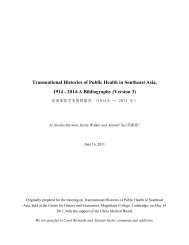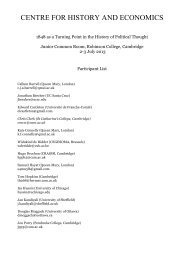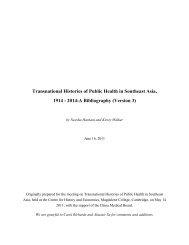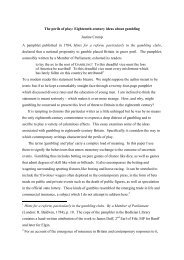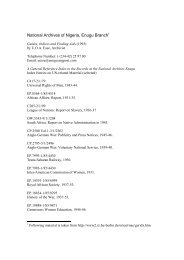Pre-industrial forests in Central Europe as objects of historico ...
Pre-industrial forests in Central Europe as objects of historico ...
Pre-industrial forests in Central Europe as objects of historico ...
Create successful ePaper yourself
Turn your PDF publications into a flip-book with our unique Google optimized e-Paper software.
10<br />
• Such approaches are to be closely connected with research on the change <strong>of</strong> the <strong>in</strong>ner condition <strong>of</strong><br />
the <strong>forests</strong> 120 with the aim <strong>of</strong> obta<strong>in</strong><strong>in</strong>g a regional balance <strong>of</strong> forest conditions <strong>in</strong> space and time <strong>as</strong><br />
composition and condition <strong>of</strong> the vegetation are likewise parameters for the above-mentioned processes<br />
121 <strong>as</strong> well <strong>as</strong> their results. It is thus necessary to <strong>in</strong>clude historic forest-use methods <strong>in</strong> its<br />
whole breadth, among others with a view to the form <strong>of</strong> stock and the composition <strong>of</strong> varieties <strong>as</strong><br />
H. Rubner 122 did for the coppice-with-standards, <strong>in</strong> order to develop a most visual representation <strong>of</strong><br />
the condition <strong>of</strong> the forest at that time. Just how necessary this is is clearly shown <strong>in</strong> the difficulties<br />
<strong>of</strong> a museum-didactic presentation <strong>of</strong> old landscape conditions <strong>in</strong> the form <strong>of</strong> exhibitions 123 .<br />
• Quantitative and qualitative changes <strong>in</strong> the structure <strong>of</strong> the forest should not be treated isolated<br />
from the social, economic and political conditions <strong>of</strong> their users. The transition to other forest-uses<br />
<strong>in</strong>fluenced permanently the economic development potential and thus the social and demographic<br />
development <strong>of</strong> a region or vice versa 124 . The propagation <strong>of</strong> forest law 125 and its realisation <strong>in</strong> silvicultural<br />
practice depends to a great extent on the effectivity <strong>of</strong> silvicultural adm<strong>in</strong>istration, the<br />
ownership conditions and the socio-economic conditions <strong>in</strong> the area <strong>of</strong> demand around a forest.<br />
Historic forest research must therefore take <strong>in</strong>to consideration the regional geography <strong>of</strong> a certa<strong>in</strong><br />
area under the <strong>in</strong>fluence <strong>of</strong> economic and legal prerequisites typical <strong>of</strong> that time (cf. Fig. 2 <strong>as</strong> example)<br />
126 .<br />
• The object <strong>of</strong> current discussion <strong>in</strong> the era <strong>of</strong> Waldsterben 127 are questions on game stock, <strong>in</strong> particular<br />
<strong>of</strong> ho<strong>of</strong>ed game, <strong>as</strong> to its importance on forest development. In spite <strong>of</strong> research for some<br />
years now by Schwenk 128 from the viewpo<strong>in</strong>t <strong>of</strong> historic geography there are still gaps <strong>in</strong> our<br />
knowledge on game population especially before 1800. Know<strong>in</strong>g full well the problems <strong>of</strong> <strong>in</strong>terpret<strong>in</strong>g<br />
relevant sources (list <strong>of</strong> shoot<strong>in</strong>gs, hunt<strong>in</strong>g dues etc.) before the background <strong>of</strong> the fact that<br />
even us<strong>in</strong>g modern count<strong>in</strong>g methods the number <strong>of</strong> deer observed stands <strong>in</strong> no proportion to the<br />
actual number exist<strong>in</strong>g 129 it would nevertheless, for several re<strong>as</strong>ons, be useful to obta<strong>in</strong> reliable <strong>in</strong>formation.<br />
The game population determ<strong>in</strong>ed to a great extent the economic welfare <strong>of</strong> a region dur<strong>in</strong>g<br />
early modern times 130 . It can, moreover, be a co-<strong>in</strong>dicator for the regeneration and ecological<br />
stability <strong>of</strong> historic <strong>forests</strong>. Research <strong>in</strong>to historic game populations is thus <strong>in</strong>separably connected to<br />
the development <strong>of</strong> <strong>forests</strong> and corresponds with conceptions <strong>of</strong> hunt<strong>in</strong>g and forest 131 . In general,<br />
exam<strong>in</strong>ation should be made <strong>as</strong> to how much the game population differed regionally, i.e. under<br />
doma<strong>in</strong>/state direction and under the <strong>in</strong>fluence <strong>of</strong> the human population density and structure 132 .<br />
Obviously baroque hunt<strong>in</strong>g enthusi<strong>as</strong>m h<strong>as</strong> <strong>of</strong>ten been overestimated <strong>in</strong> its <strong>in</strong>fluence on silviculture<br />
and h<strong>as</strong> been seen too much <strong>as</strong> a whole 133 . The systematic exam<strong>in</strong>ation <strong>of</strong> early modern hunt<strong>in</strong>g extent<br />
would, us<strong>in</strong>g knowledge <strong>of</strong> specific demands <strong>of</strong> the animals on their environment 134 , also create<br />
the possibility <strong>of</strong> prov<strong>in</strong>g that various forms <strong>of</strong> biocoenobitism are reflected <strong>in</strong> it, <strong>in</strong> which c<strong>as</strong>e



